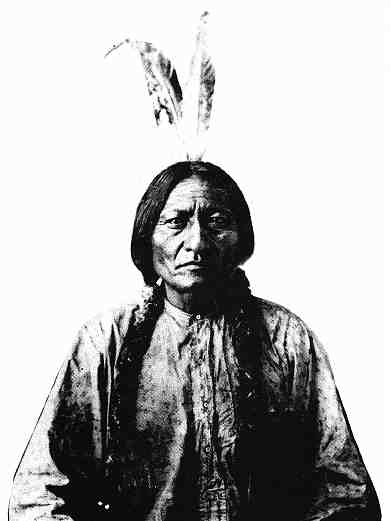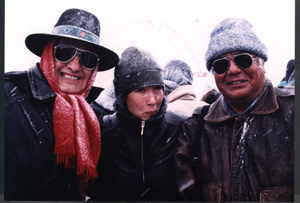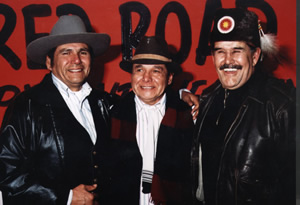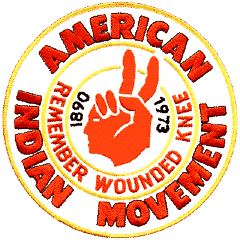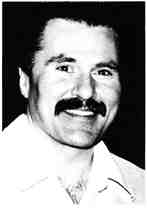
Charles Abourezk
IITC Legal Counsel |
Charles is an attorney, newspaper columnist and contributing editor for Native Nations Magazine. He is known for his precise and humorous critiques of institutional racism. He is also a Human Rights Specialist who represented the International Indian Treaty Council at the United Nations Commission on Human Rights for five years. He is a founder of KILl Radio on the Pine Ridge Indian Reservation - a station that provides critical communication for various remote communities. He is former director and producer of nationally syndicated "First Person Radio" and former Minority Affairs Producer for South Dakota Public Television. He is an expert on treaties, federal Indian law and tribal law and is currently an adjunct professor for Oglala Lakota College in the "Manager as Warrior" Graduate Studies Program.
- Anti-Indian Racism
- Development on Indian Reservations
- Indigenous Human Rights
- Federal Indian Law & Tribal Law
|
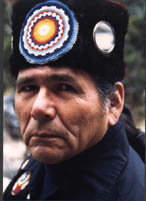
Dennis
J. Banks
Anishinabe
- Ojibwe Nation
{Minnesota}
|
Dennis Banks—Native American leader, teacher,
lecturer, activist, and author—is an Anishinabe, Ojibwa,
born on Leech Lake Indian Reservation in northern Minnesota. In
1968 he co-founded the American Indian Movement (AIM), and establishing
it to protect the traditional ways of Indian people and to engage
in legal cases protecting treaty rights of Natives-such as hunting
and fishing, trapping, wild riceing.
Banks earned an Associates of Arts degree at Davis University
and taught at Deganawida Quetzecoatl (DQ) University (an all Indian-controlled
institution), where he became the first American Indian chancellor.
In 1994, Banks led the four-month Walk for Justice (WFJ) from
Alcatraz Island in San Francisco to Washington, DC. The purpose
was to bring public awareness to current Native issues. Banks
agreed to head the "Bring Peltier Home" campaign in
1996 bringing Native Americans and other supporters together in
a national drive for executive clemency for political prisoner
Leonard Peltier. He also had roles in the movies War Party, The
Last of the Mohicans, and Thunderheart. A musical tape "Still
Strong" featuring Banks’ original work as well as traditional
Native American songs was completed in’93 and a musical video
with the same name was released in’95.
|
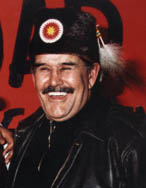
Clyde
Bellecourt
(Nee-gon-we-way-we-dun)
Anishinabe - Ojibwe Nation
{Minnesota}
|
Clyde is a founder and Director of the American Indian Movement. He was a major figure in the occupation of Wounded Knee in 1973 and played a founding role in an ongoing Indian School System, Legal Rights Center and the International Indian Treaty Council. He is also directing the Peacemaker Center for Indian youth and the AIM Patrol which provides security for the Minneapolis Indian community. He is an organizer of the National Coalition on Racism in Sports and the Media. He is founder and currently Chairman of the Board of American Indian OIC, an innovative job program that has moved over 14,000 people from welfare to full-time employment. Clyde sees a bright future: "This generation of little children is the 7th Generation. Not just Indian children but white, black, yellow and red. Our grandfathers said the 7th generation would provide new spiritual leaders, medicine people, doctors, teachers and our great chiefs. There is a spiritual rebirth going on."
- The American Indian Movement: Past, Present & Future
- Racism in Sports & The Media
- Alternative, Culturally-Based Indian Education
- American Indian Opportunities, Industrialization Centers
|
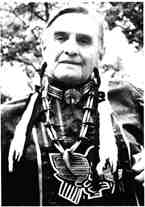
Vernon Bellecourt
(WaBun-Inini)
Anishinabe - Ojibwe Nation
{Minnesota} |
In Loving Memory of Vernon Bellecourt,
10/17/31-10/13/07
Vernon is a principal spokesman for the American Indian Movement
and a leader in actions ranging from the 1972 occupation of the Bureau of Indian
Affairs in Washington to the 1992 Redskin Superbowl demonstrations. He is
Co-founder and first Executive Director of the Denver AIM Chapter. His
involvement at Wounded Knee in 1973 led to a Federal indictment. He is a special
representative of the International Indian Treaty Council and helped organize the first Treaty Conference in 1974. He was jailed for throwing his blood on the Guatemalan Embassy to protest the killing of 100,000 Indians. He was elected to a 4-year term in his White Earth tribal government and developed a model program for the spiritual education of Indian prisoners. Vernon is President of the National Coalition on Racism in Sports & Media and recipient of the City of Phoenix, Martin Luther King Human Rights Award 1993.
- Spiritual, Cultural, Philosophical, Ideological, Social, Economic, & Political Realities
- The American Indian Movement: 1492 to the Present
- The International Indian Treaty Council: 1974 to the Present
- Indian Tribal Law, and International Treaty Law
- Constitutional Rights, FBI/CIA Surveillance & Covert Action
- Mascots & Stereotypes
|

Edward Benton Banai
Bawd way wi
dun Banaise
Lac Court Orielles Band, Ojibway Nation
{Wisconsin } |
Eddie is a Spiritual Teacher of the Lac Court Orielles Band of the Ojibway Nation. He was the founder of Red School House, an Indian-controlled school with 150, K through 12 Indian students. He is a pioneer in culture-based curriculum and Indian alternative education who believes that education should be built on identity, spirituality, music, heritage and pride. As author of The Mishomis Book (Indian Country Press), Eddie has set down the oral history of the Ojibway nation and presented his life within the family circle. He learned from the tribal elders who possessed the memories and wisdom of the Ojibway and carefully preserved the ancient traditions. The book is an account of the culture, history and philosophy of the Ojibway. Eddie believes, "It is time to talk with our Brothers and Sisters of other nations, colors and beliefs. The ideas and philosophies of yesterday may be the key to the world family's future." Eddie has a Master's Degree in Education and is Co-founder of the American Indian Movement.
- Indian Alternative Education & Culture -Based Curriculum
- The Ancient Teachings & Traditions of the Ojibway: a Guide to Modern Living
|
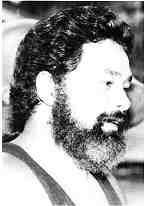
Nathan Keliikui Brown
Kingdom of Hawaii |
Nathan coordinates Research & International Law for the Ohana (family) Council - a leading organization in the dynamic Native Hawaiian movement to re-assert independence & self-determination. In 1878 Captain Cook came upon, "400,000 island residents with a well-developed, flourishing culture and lifestyle. They were robust & healthy and had a coherent system of spiritual beliefs, economics and scholarship." In 1893 armed white settlers and the U.S.Marines overthrew the Sovereign Hawaiian Kingdom in violation of a Treaty of Peace & Friendship. For Nathan's people, self-determination is the right to choose ones destiny in compliance with The U.N. Charter, Article 73. Nathan is of Kanaka Mooli (Hawaiian) descent from a family of 14 children raised in a rural lifestyle in the heart of Downtown Honolulu. After several arrests, he is under federal indictment for exercising his human rights. He is currently assisting Kanaka Maoli communities with the Ohana Council Self-government Charter that lays a foundation for self-determination & self-governance. Nathan engages in eloquent unveiling of truth through the spirit of Aloha.
- Successes of the Native Hawaiian Sovereignty Movement
- Indigenous Self-Determination as Guaranteed by the U.N. Charter
- Cultural Survival Based on Rights to Develop Self-Sufficient & Self-Reliant Economies
|
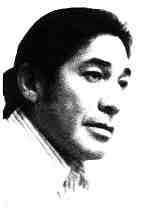
Robert Cruz
Tohono Q'odham Nation
{Papago, Arizona} |
Robert was raised by his grandparents in a typical traditional home in the beautiful Sonoran desert. His family ranched and farmed in a climate that required a relentless quest for water. After ages of harmonious living his people were invaded by the U.S. and Mexico. The enforced border created profoundly complex legalities resulting in extreme violations of land and human rights. As the Southwest Coordinator of American Indians Against Desecration, he assisted in the passage of the Native American Graves Protection and Repatriation Act. He helped in recovering the remains of 6,000 Indian ancestors from institutions and private collections for reburial. He works with the World Archeological Congress of professionals dedicated to ethical archeology. As board member of the Treaty Council, he works extensively at the U.N. and recently provided security for Rigoberta Menchu in Guatemala during the coup d'etat. He is 1993 recipient of the Bill Wahpepah Memorial Human Rights Award.
- Native Rights, Human Rights & Environmental Protection
- The Native American Grave Protection & Repatriation Act (NAGPRA)
- Cultural Preservation & Community Organization
- Police Abuse & Prisoner Rights
|
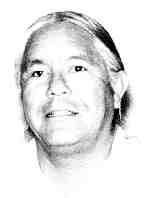
Lenny Foster
Diné Nation
{Navajo, Arizona} |
Lenny is the Director of the Navajo Nation Corrections Project and the Spiritual Advisor for 1,500 Indian inmates in 34 state and federal prisons in the Western U.S. He has co-authored legislation in New Mexico, Arizona and Colorado that allows Native American spiritual and religious practice in prison and results in significant reductions in prison returns. He is a board member of the International Indian Treaty Council, a sun dancer and member of the Native American Church. He has been with the American Indian Movement since 1969 and has participated in actions including Alcatraz, Black Mesa, the Trail of Broken Treaties, Wounded Knee '73, the Menominee Monastery Occupation, Shiprock Fairchild Occupation, the Longest Walk and the Big Mountain land struggle. He was a 1993 recipient of the City of Phoenix, Dr. Martin Luther King Human Rights Award.
- Religious Freedom for Indians in Prison
- Using the Spiritual Path to Avoid Being Institutionalized
- Sovereignty Self-Determination & Human Rights
|
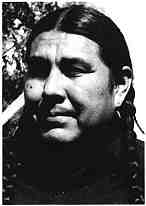
Tom Goldtooth
Diné Nation |
Tom is a spokesperson for the Indigenous Environmental Network (lEN). lEN is a national, grassroots, environmental organization involved with stopping toxic and nuclear dumping on or near Indigenous lands and with leading the struggle to reform national environmental, economic and energy policies that are genocidal to Indigenous people. Tom is the Coordinator of the Red Lake Nation (Minnesota) Environmental Protection Department that is developing an Indigenous environmental infrastructure based on traditional eco-knowledge. He is involved with local, state, national and international issues directly related to the environmental justice movement. He advises various science and historical museums on the repatriation, deassessment and reburial of human remains and return of cultural items. He is dedicated to the empowerment of grassroots communities, maintaining Indigenous traditional values, and the protection of Indigenous rights and self-determination. He believes that to work for the struggle of protecting the earth, one has to respect the sacredness of the creative principle of women that is rooted in Mother Earth.
- Traditional Eco-Knowledge & Sustainable Community
- Environmental Protection On and Near Indigenous Lands
- Cultural and Spiritual Preservation
- Indigenous Deep Ecology: Rethinking Our Relationship to the Land and Each Other
- Environmental Racism & the Environmental Justice Movement
|
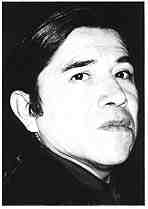
Antonio Gonzales
Seri/Chicano
{California} |
Tony is U.N. Liaison Officer and coordinates Treaty Council participation at the U.N. Commission on Human Rights in Geneva. He works with the U.N. Working Group on Indigenous Populations to complete the Universal Declaration on the Rights & Principles of Indigenous Peoples - a document that will establish a standard for countries to co-exist with Indigenous Peoples. In 12 years at the Treaty Council he has Coordinated Community Outreach and Research & Documentation and been Director of Operations. He has met Gorbachev, Arafat, Nelson Mandela} and other world leaders to discuss Indigenous Sovereignty, environmental degradation, religious freedom, torture and political persecution. A current focus is a U.N. study on nation/state violations of Treaties. At the 1993 U.N. World Conference on Human Rights, he helped successfully lobby countries to call for an International Decade of Indigenous Peoples. He helps build unity between Indigenous people of all colors by emphasizing their shared history and common vision for the future. As a Vietnam combat veteran, Tony lived the horror of war and was inspired to work for human rights.
- Current U.N. Developments Affecting Indigenous People
- Evaluation of the U.N. Working Group on Indigenous Populations
- Sovereignty Human Rights & Environmental Protection
|
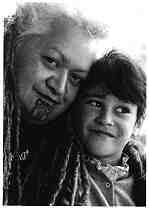
Hinéwirangi
& daughter Anewa
Maori Nation, Aotearoa
{New Zealand} |
Hiné is Coordinator of the Maori Women's Resource Center and a Representative of the Nuclear Free and Independent Pacific movement. She is a Board Member of the International Indian Treaty Council and has served as Co-Director. She is mother of two children and has mothered several others. She has published four volumes of poetry, is currently working on a novel and has written and directed 6 videos for children about recognizing sexual abuse. She has written many dramas reflecting her culture. Her life's work has been with women and children, healing effects of abuse. She conducts workshops on all aspects of the Maori philosophy: the Hinengaro - Mental well being; the Wa}irua} - Spiritual well-being; the Wha}na}u - Family well-being; and the Tinana - Physical well-being. Hiné also does workshops on: traditional Maori healing; indigenous poetry writing; creating indigenous drama; Maori parenting; traditional women in this new world; Maori flute making; healing women's pain; and traditional views of sex & sexuality.
- Sovereignty & the Effects of Colonization on Indigenous Peoples
- The Healing of Our People That Lies Within Our Own Cultures
- Learning the Interconnectedness Throughout the Indigenous Women's World
|
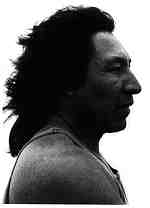
Puksu lgualikinya
Kuna Nation
{Panama} |
Puksu challenges the environmental movement to not only defend forests, water and animals, but indigenous people as well. "Whenever natural resources are discovered on Indian land, governments try to push the Indians out. Indian people want to reclaim their territories, practice their religions & educate in their own way." The Kunas maintain their autonomy and protect their pristine environment on the tropical islands and rainforests of Panama. They have their own national congress and armed forces to protect their sovereignty and traditional way of life. Puksu is on the Board of the International Indian Treaty Council and is the Kuna representative at the U.N. Human Rights Commission. In 1972 he co-organized the Kuna Youth Movement and remains international representative. He co-organized the World Congress of Indigenous Peoples and Co-founded the Indigenous Organization of Central America & Mexico. He was keynote speaker at major European conferences on Indigenous Peoples & Tropical Rainforests and also at two Rainfo rest Action Network conferences. He was featured speaker at the Madrid Conference on Indigenous Resistance to the 500 Year Invasion.
- Protecting Indigenous People as Well as the Environment
- Sovereignty Self-Determination & Human Rights
- Kunaagri culture & Ecology
- The Kuna Experience Wwith Autonomy in Panama
|

Sarah James
Gwich'in Athabascan Nation
{AIaska} |
Sarah is Chair of the Gwich'in Steering Committee made up of representatives from villages of the ancient caribou culture. Sarah represents her people under the direction of the village elders and is dedicated to protecting the caribou herd and the basic tribal and human right to continue the Gwich'in way of life in the same place as it has been for thousands of years. She is a Member of the Arctic Village Traditional Council and lives 150 miles from the nearest highway. The Gwich'in and supporters have stopped the proposed oil drilling in the Arctic National Wildlife Refuge for now. However, Sarah continues to be gravely concerned about the effect global warming may be having on the Caribou herd. The unprecedented warm weather is altering plant and animal life. She is a Board Member of the International Indian Treaty Council and travels the world recruiting help for the Gwich'in and supporting other Indigenous efforts to protect land and culture. Her people feel it is their responsibility to keep the land pure and pass it onto all Indian and non-Indian generations to come.
- Oil Drilling & Global Warming: Continued Threats to the Arctic National Wildlife Refuge
- Protecting Traditional Life with the Caribou
- Indigenous Peoples: Part of the Ecology That Must Be Protected
|
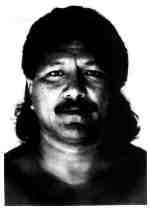
Dennis "Bumpy" Kanahele
Hawaiian Kingdom |
Bumpy is a coordinator and spokesperson for the Ohana (family) Council - a vital organization in the Native Hawaiian movement to re-establish sovereignty. 1993 marked 100-years since the U.S. invasion & annexation of the Hawaiian Kingdom in violation of a Treaty of Peace & Friendship. The Hawaiians have never relinquished their valid titles and rights in spite of a military occupation that has accommodated desecration and exploitation of their lands, inland waters and ocean fisheries. In the 80's Bumpy took part in land claim occupations that ended in armed stand-off and resulted in a one-year prison term. Tactics consistent with the spirit of Aloha were used in 92 when he and 31 others were arrested at lolani Palace in a civil resistance that stirred up the State Government of Hawaii. Soon after, the Ohana Council of the Hawaiian Kingdom formed with A Charter for Self-Governance, under the U.N. Charter, Article 73. In 93 Bumpy was appointed to the Governor's Advisory Commission on Hawaiian Sovereignty. He is the newest Board Member of the International Indian Treaty Council, replacing the beloved Kawaipuna Prejean who passed into the spirit world in 1992.
- Successes of the Native Hawaiian Sovereignty Movement
- Indigenous Self-Determination as Guaranteed by the U.N. Charter
- Cultural Survival Based on Rights to Develop Self-Sufficient & Self-Reliant Economies
|
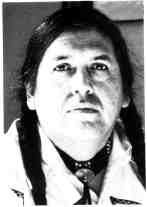
William Means
Oglala Lakota
{Sioux, South Dakota} |
Bill is a founder of the International Indian Treaty Council and currently President of the Board. During his 9 years as Executive Director, he was responsible for the establishment of a system for documenting human rights violations against Indians. He is Co-founder of the U.N. Working Group on Indigenous Populations and an expert on U.S. & Indian Treaty relations. He was Executive Director of American Indian O.I .C., a job center that has placed over 14,000 people in full-time employment. He has been on the Grand Governing Council of the American Indian Movement since 1972. He is a veteran of Wounded Knee 1973 and helped coordinate legal defense work on over 500 Wounded Knee federal indictments. Bill has extensive negotiating experience with tribal, city, state, federal and international agencies. For 5 years he was Executive Director of the Heart of The Earth Survival School for Indians. He is on the Board of the World Archeological Congress and has lectured extensively at major universities here and abroad. He graduated from Black Hills State U, has been in many environmental campaigns including the Black Hills Alliance and is a Vietnam combat veteran.
- Human Rights, Self-Determination & Indigenous Peoples
- Treaty Rights, Sovereignty & Environmental Protection
- Culturally Based Curriculum & Indian Education
- Job Training & Placement and Indian Gaming
|
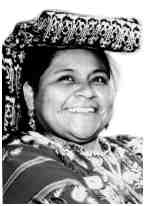
Rigoberta Menchu
Maya Quiché
{Guatemala} |
Rigoberta won the 1992 Nobel Peace Prize. She is a leader in the Guatemalan people's effort to establish human rights and economic democracy in spite of a ruling class & Army that has killed more than 50,000 Indians since 1979. During the 1993 coup she joined 60,000 Guatemalans in the streets who forced the dismissal of the President. I, Rigoberta Menchu, An Indian Woman in Guatemala, is her story. She was active in Christian base communities and the Committee for Campesino Unity, an agricultural workers' union. In 1980 her father and 38 others were murdered when the Spanish Embassy, where they had sought refuge, was burned to the ground by Guatemalan security forces. The Army kidnapped, tortured, and killed her mother and brother. In 1981 she fled. Since 1982 Rigoberta has been active in the U.N. Human Rights Commission, Working Group on Indigenous Peoples. She has been on the International Indian Treaty Council Board since 1986. She created the Vicente Menchu Foundation, in memory of her father, for the purpose of searching for peaceful solutions to armed conflicts and promoting human rights & grassroots development.
- The Struggle for Economic & Social Democracy in Guatemala
- Peace & Human Rights: an International Decade for Indigenous People
|
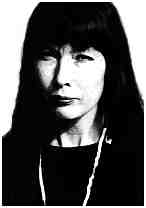
Charlene Teters
(Slum Tah)
Spokane Nation
{State of Washington} |
Charlene is an artist and Professor at the Institute of American Indian Arts in Sante Fe, and senior editor of Indian Artist Magazine. She is on the board of the National Coalition on Racism In Sports & Media. She, Vernon Bellecourt, Mike Haney and other AIM people were assaulted by fans and U of Minnesota Police at a 1992 basketball game for peacefully demonstrating against the U of Illinois mascot - a dancing white student in an eagle-feathered headdress called Chief Illiniwak. She established the Office of Racial Justice for the National Congress of American Indians. Charlene is an accomplished artist featured in over 21 major exhibitions, commissions & collections. She is a Spokane, indigenous to the plateau region of what is now Washington state and works to support Indian children striving to transcend poverty and unemployment. Her politically powerful art attacks racist stereo-types that undermine Indian selfesteem. "Indians are human beings, not mascots. Warriors withiur society are about peace and life."
- Mascot Issues & Racism
- Environment, Human Rights, Diversity & Racism
- Indian Art, Gender Roles in Art, Racism in Education
- Indian Grave Desecration & Repatriation
- Appropriation & Abuse of Indian Spirituality & Sacred Items
|

Floyd Red Crow Westerman
Dakota
{Sisseton Sioux, South Dakota} |
In Loving Memory of Floyd Red Crow Westerman, 8/17/36-12/13/07
Red Crow is Indian actor, singer, songwriter and advocate. He made his big screen debut in the movie "Renegades" and is best remembered for his role as elder/leader Ten Bear in "Dances With Wolves". His songs like "Custer Died For Your Sins" and "BIA Blues" have helped spread the American Indian Movement's message throughout the world. He has had featured roles in "Northern Exposure", "L.A. Law" and many other television series and movies. He performs with countless musicians including Willie Nelson, Bonnie Raitt and Don Henley in large benefit concerts for Indian self-determination, human rights and environmental protection. He toured the world with Sting to publicize the plight of the Rainforest People who are dying along with the Rainforests and, as caretakers, must be protected if the rainforests are to go on providing for all life on Earth. Red Crow has been an ambassador of good will representing the International Indian Treaty Council from the time of its inception. He is chairman of the Board for the National Coalition on Racism in Sports & Media. His concerts and lectures are characterized by sharp wit and humorous but solution-oriented critiques of Western Civilization.
- Sovereignty Human Rights & the Environment
- The Plight of Rain Forest People
- The Evolving Hollywood Image of Indians
|
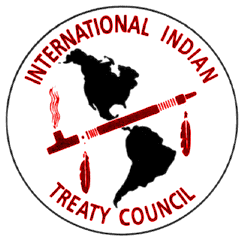
|
The Year of the World's lndigenous Peoples is the outcome of a decade of United Nations work with indigenous peoples that focused primarily on violations of their human rights. Yet every aspect of the lives of the indigenous -- their detailed knowledge, their technical skills, their reverence towards nature and the environment -- is altering the way we view the worid and challenging deeply-rooted assumptions about "progress" and "development."
- United Nations |
|
